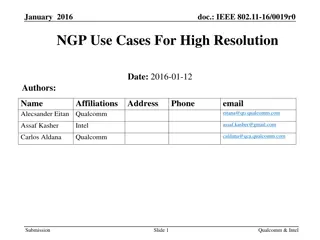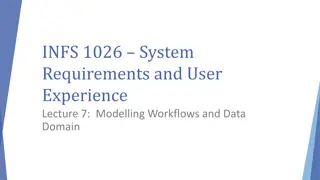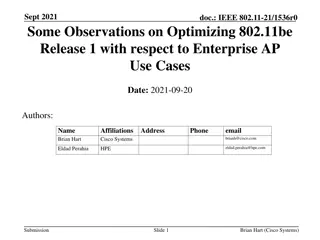NVDIMM High-Level Use Cases Overview
Explore various high-level use cases for NVDIMM technology, including local NVDIMM kernel access, SW RAID configurations, and NVDIMM utilization in both public and private cloud environments. These scenarios involve accessing, caching, and replicating data using NVDIMMs to enhance memory performance and reliability.
Uploaded on Sep 16, 2024 | 0 Views
Download Presentation

Please find below an Image/Link to download the presentation.
The content on the website is provided AS IS for your information and personal use only. It may not be sold, licensed, or shared on other websites without obtaining consent from the author. Download presentation by click this link. If you encounter any issues during the download, it is possible that the publisher has removed the file from their server.
E N D
Presentation Transcript
Local and Remote byte-addressable NVDIMM High-level Use Cases Chet Douglas Principal NVDIMM SW Architect - DCG 09-11-15
USE CASE Local NVDIMM Kernel Access -Memory Side Cache -Hierarchical Tiered Memory Client Workstation or Enterprise Server On Package High-Bandwidth Memory Hierarchical Tiered Memory and Caching -On-Package High-Bandwidth Memory caching DDR4 main memory -DDRT4 Main Memory caching byte-addressable NVDIMM -NVDIMM caching SSDs -Typical OS implementations will require extensive kernel access DDR4 Main Memory Byte addressable, direct access, NVDIMM SSD Asynchronous Demand On Package High-Bandwidth Memory Cache Requests Asynchronous Demand On Package High-Bandwidth Memory Cache Completions Asynchronous Demand DDR4 Main Memory Cache Requests Asynchronous Demand DDR4 Main Memory Cache Completions Asynchronous Demand Byte-Addressable NVDIMM Cache Requests (Writes, Flushes, Commits) Asynchronous Demand Byte-Addressable NVDIMM Cache Completions Asynchronous Demand SSD Requests Asynchronous Demand SSD Completions
USE CASE Local NVDIMM Kernel Access -SW RAID Close R5 Write Hole -SW RAID Cache for SSD RAID Volumes SSD RAID Volume Acceleration Cache Byte addressable, direct access, NVDIMM SSD RAID-5 Volume Write Hole Temp Data Store SW RAID Use Cases Kernel Access -Typically SW RAID products utilize OS Kernel RAID Storage Drivers and UEFI RAID Pre-Boot drivers to implement SW RAID functionality. -Performance acceleration caches or caches to close vulnerabilities in RAID Data replication, require shared persistent kernel access to regions of the NVDIMM by both UEFI RAID Pre-Boot drivers and OS Kernel RAID Storage Drivers Byte addressable, direct access, NVDIMM Client Workstation or Enterprise Server SSD SSD RAID Volume Asynchronous Demand SW RAID Acceleration Cache Requests Asynchronous Demand SW RAID Acceleration Cache Completions Asynchronous Demand SW RAID Data Vulnerability Cache Requests Asynchronous Demand SW RAID Data Vulnerability Cache Completions Asynchronous Demand SW RAID Requests Asynchronous Demand SW RAID Completions
USE CASE Local & Remote NVDIMM Public & Private Cloud -Synchronous (1:1) (active:passive) -Database Replication PUBLIC & PRIVATE CLOUD Active Server Node Active Server Node Database copies kept in lock step Client Synchronous Passive Database Slave Active Database Master Byte addressable, direct access, NVDIMM Byte addressable, direct access, NVDIMM Asynchronous Demand Database Master Updates Asynchronous Database Replication - RDMA Write Synchronous Database Replication SNIA Optimized Flush Synchronous Database Replication SNIA Optimized Flush Completion Asynchronous Demand Database Reads
USE CASE Local & Remote NVDIMM Public & Private Cloud -Asynchronous (1:1) (active:passive) -Database Replication PUBLIC & PRIVATE CLOUD Active Server Node Database copies updated asynchronously as logfile updates are pushed to slave nodes Database Master Logfile Client Database Slave Logfile Active Server Node Active Database Master Asynchronous Passive Database Slave Byte addressable, direct access, NVDIMM Byte addressable, direct access, NVDIMM Asynchronous Demand Database Master Updates Local Logfile Update due to Database update Asynchronous Database Logfile Replication - RDMA Write Synchronous Database Logfile Replication SNIA Optimized Flush Synchronous Database Logfile Replication SNIA Optimized Flush Completion Local Database Update due to Logfile update Asynchronous Demand Database Reads
USE CASE Remote NVDIMM Public & Private Cloud -Converged Disaggregated Network Topology -SW Defined Storage (SDS) PUBLIC & PRIVATE CLOUD Storage Processing Node Direct Attached NVDIMM Compute Node Virtual Clients (IaaS/PaaS) Byte addressable, direct access, NVDIMM Compute Node Asynchronous Demand SDS Updates Converged Disaggregated Network Topology Compute Nodes and Storage Processing Nodes are physically separate nodes Asynchronous Storage Updates - RDMA Write Synchronous Storage Updates SNIA Optimized Flush Synchronous Storage Updates SNIA Optimized Flush Completion Asynchronous Demand SDS Reads
USE CASE Remote NVDIMM Public & Private Cloud -Hyper-Converged Network Topology -SW Defined Storage (SDS) PUBLIC & PRIVATE CLOUD Compute Node Virtual Network Compute Node Virtual Clients (IaaS/PaaS) Virtual Storage Processing Node Compute Node Direct Attached NVDIMM Byte addressable, direct access, NVDIMM Asynchronous Demand SDS Updates Asynchronous Storage Updates - RDMA Write Hyper-Converged Network Topology Compute Node and Storage Processing Node are in the same physically node Synchronous Storage Updates SNIA Optimized Flush Synchronous Storage Updates SNIA Optimized FlushCompletion Asynchronous Demand SDS Reads
USE CASE Remote NVDIMM Enterprise Appliance Enterprise Server Storage Processing Node Network Attached Enterprise Appliance Direct Attached NVDIMM Storage Attached Enterprise Appliance w Internal Network Fabric Switch & Direct Attached NVDIMM Enterprise Server Compute Node Byte addressable, direct access, NVDIMM Byte addressable, direct access, NVDIMM Asynchronous Storage Updates Asynchronous Appliance Updates - RDMA Write Synchronous Appliance Update SNIA Optimized Flush Synchronous Appliance Update SNIA Optimized FlushCompletion
USE CASE Remote NVDIMM HPC PGAS, SHMEM, MPI, Human Brain Project -Distributed (1:N) (active:active) Database IO typically <= 256Bytes, Key/Value pair or pointer updates Active Server Node Synchronous Distributed Database Active Server Node Byte addressable, direct access, NVDIMM Synchronous Distributed Database Distributed Database Reference Byte addressable, direct access, NVDIMM Active Server Node Client Synchronous Distributed Database Byte addressable, direct access, NVDIMM Active Server Node Asynchronous Demand Database Updates Database is distributed across many nodes all actively taking part in Database references and updates Asynchronous Database Updates - RDMA Write Synchronous Distributed Database Asynchronous Database Replication SNIA Optimized Flush Asynchronous Database Replication SNIA Optimized FlushCompletion Asynchronous Demand Parallel Database Reads Byte addressable, direct access, NVDIMM
USE CASE Remote NVDIMM HA & HPC -Synchronous (1:N) (active:passive) -Database Replication w Parallel Access High Availability Database copies kept in lock step Active Server Slave Node Active Server Node Synchronous Database Slave Active Server Slave Node Client Byte addressable, direct access, NVDIMM Database Master Synchronous Database Slave High Performance Computing - Parallel Database Reads typically load-balanced across all Passive Server Nodes Active Server Slave Node Byte addressable, direct access, NVDIMM Byte addressable, direct access, NVDIMM Synchronous Database Slave Asynchronous Demand Database Master Updates Byte addressable, direct access, NVDIMM Asynchronous Database Updates - RDMA Write Synchronous Database Replication SNIA Optimized Flush Synchronous Database Replication SNIA Optimized FlushCompletion Asynchronous Demand Parallel Database Reads - RDMA Read

























